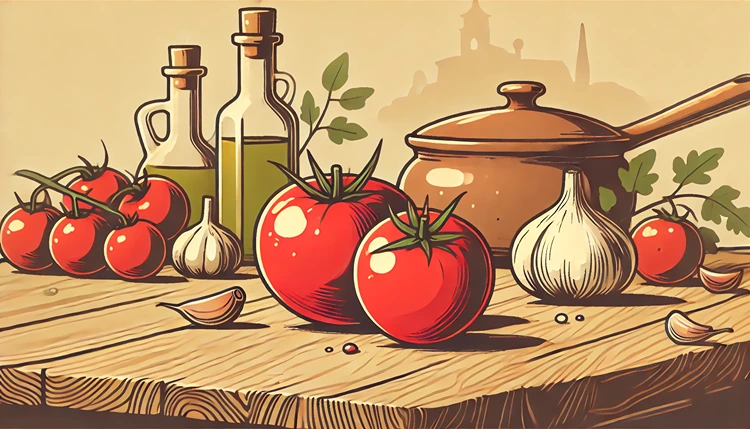Spanish tomatoes are more than just an ingredient; they represent the heart and soul of many iconic dishes. Known for their rich flavor, vibrant color, and versatility, these tomatoes have a unique role in Spanish culinary traditions. Whether you’re making a simple gazpacho or a more complex sofrito, the importance of Spanish tomatoes cannot be overstated.
The perfect growing conditions in Spain, from the sun-drenched fields to the Mediterranean climate, contribute to producing some of the world’s tastiest tomatoes. But why do these tomatoes play such a significant role in cooking? It’s not just about their taste—it’s about how they shape the dishes themselves, elevating even the simplest meal into something extraordinary.
What Makes Spanish Tomatoes Different from Others?
When it comes to flavor, Spanish tomatoes are in a league of their own. They are known for their bright, slightly sweet taste balanced by a tangy acidity, making them ideal for both raw and cooked dishes. But what really sets them apart?
- Rich flavor profile: Spanish tomatoes are often described as earthy, sweet, and tangy, which gives them a unique flavor balance that can transform any dish.
- Perfect climate: The warm, sunny climate of Spain allows tomatoes to ripen fully, developing deep flavors that can’t be found in tomatoes grown in colder regions.
- Variety of types: From the large, meaty ‘Raf’ tomatoes to the small, intensely flavored ‘Pera’ tomatoes, Spain offers a diverse range of tomato varieties, each contributing differently to various dishes.
Helpful Hint:
If you’re looking to replicate authentic Spanish flavors, it’s worth seeking out Spanish tomato varieties like ‘Raf’ or ‘Pera’ tomatoes. Their natural sweetness and complex flavors can elevate your dishes to a whole new level.
Spanish Tomato Varieties and Their Best Uses
| Tomato Variety | Flavor Profile | Best Used In |
|---|---|---|
| Raf | Sweet, Slightly Acidic | Fresh salads, pan con tomate |
| Pera | Meaty, Mildly Sweet | Sofrito, Sauces, Stews |
| Corazón de Buey | Rich, Juicy | Raw, Sliced, in Sandwiches |
| Cherry Tomato (Tomate Cherry) | Intensely Sweet | Roasted, Skewers, Tapas |
| Kumato | Complex, Earthy | Salads, Garnishes, Raw Use |
How Do Spanish Tomatoes Influence Traditional Dishes?
Spanish cuisine is steeped in tradition, and tomatoes are a fundamental part of many classic recipes. Their presence is felt across the country, from Catalonia to Andalusia, and each region has its own unique way of incorporating this fruit into their cooking.
One of the most famous examples is the use of tomatoes in pan con tomate, a simple yet iconic dish made by rubbing ripe tomatoes onto crusty bread, drizzling it with olive oil, and sprinkling it with salt. In this dish, the tomatoes are front and center, showcasing their natural flavor with minimal interference from other ingredients.
What Are Some Famous Spanish Dishes Featuring Tomatoes?
Tomatoes are the cornerstone of several Spanish dishes that have become staples both within Spain and internationally. Let’s take a look at a few:
- Gazpacho: This cold tomato soup is synonymous with Spanish summers. Blending tomatoes, cucumbers, peppers, and garlic, gazpacho highlights the refreshing, bright flavor of raw tomatoes.
- Sofrito: A slow-cooked tomato-based sauce that forms the foundation of many Spanish stews, rices, and meats, sofrito demonstrates the deep, savory flavor tomatoes can bring to more complex dishes.
- Salmorejo: A richer, thicker cousin of gazpacho, salmorejo uses tomatoes and bread to create a creamy soup, often garnished with jamón or boiled eggs. It’s a popular dish in Andalusia and a perfect example of the versatility of tomatoes.
Why Is the Seasonality of Spanish Tomatoes Important?
One of the secrets behind the exceptional quality of Spanish tomatoes is their seasonality. While tomatoes are available year-round, the best time to enjoy them is during the summer and early autumn, when they are at their peak ripeness.
During the height of the tomato season, the fruit is bursting with flavor, offering a sweet, juicy texture that’s perfect for fresh dishes like salads, cold soups, and pan con tomate. Off-season tomatoes, in contrast, often lack the depth of flavor and sweetness that make Spanish tomatoes so special.
Stats:
Spain produces over 4 million tons of tomatoes annually, with a large portion being exported. Spanish tomatoes are not only a culinary staple at home but also highly sought after globally, contributing significantly to the country’s economy.
How Can You Select the Best Spanish Tomatoes?
Choosing the right tomato can make all the difference in your dish. When selecting Spanish tomatoes, there are a few things to keep in mind:
- Look for tomatoes that feel heavy for their size—this indicates they are full of juice.
- The skin should be smooth, free of blemishes, and have a vibrant, rich color.
- Give the tomato a gentle squeeze. It should be slightly firm but yield slightly to pressure, signaling it’s ripe and ready to use.
Another trick is to rely on your nose—ripe tomatoes should have a sweet, earthy aroma, especially around the stem area. This scent is a good indicator of their flavor intensity and freshness.
What Are the Health Benefits of Spanish Tomatoes?
Aside from their culinary importance, Spanish tomatoes offer numerous health benefits, making them a powerhouse ingredient in your diet. They are rich in vitamins A, C, and K, along with antioxidants like lycopene, which has been linked to numerous health benefits.
Incorporating tomatoes into your daily meals can support heart health, improve digestion, and even reduce the risk of certain types of cancer. The high water content also helps with hydration, making them an ideal food for hot climates like Spain’s.
Helpful Hint:
To maximize the health benefits of tomatoes, try cooking them in olive oil. This enhances the absorption of lycopene, a potent antioxidant, making it easier for your body to take advantage of its benefits.
How Are Spanish Tomatoes Used in Modern Spanish Cooking?
While traditional dishes like gazpacho and pan con tomate have been around for centuries, modern Spanish chefs are continually finding new and inventive ways to incorporate tomatoes into their recipes. The versatility of tomatoes allows them to fit into contemporary cuisine just as seamlessly as traditional cooking.
In modern Spanish cuisine, you might find tomatoes featured in avant-garde dishes, such as tomato foam or dehydrated tomato chips used as garnishes. Some chefs also experiment with molecular gastronomy, transforming tomatoes into gels or essences to concentrate their flavor. The idea is to push the boundaries of what tomatoes can do while still honoring their essential place in Spanish food culture.
Are Spanish Tomatoes Used Differently in Regional Cooking?
Absolutely! Spain is known for its diverse regional cuisines, and the use of tomatoes can vary depending on where you are in the country.
- Catalonia: In Catalonia, you’ll find tomatoes used in escalivada, a dish featuring roasted tomatoes, peppers, and onions, often served with anchovies. Catalonia’s love for simple, fresh ingredients allows the tomatoes to shine.
- Andalusia: Here, the cold soups gazpacho and salmorejo are staples, making full use of the region’s sun-ripened tomatoes during the hot summer months.
- Basque Country: In this region, tomatoes are commonly used in pintxos (small snacks), either as a spread or as part of skewered dishes that highlight the contrast between fresh tomatoes and rich meats like jamón or chorizo.
What Is the Role of Tomatoes in Spanish Food Markets?
In Spanish markets, tomatoes are more than just a product; they are a symbol of local agriculture and a source of pride for many regions. Visiting food markets across Spain, you’ll notice an impressive variety of tomatoes on display, with each vendor proudly showcasing the fruits of their labor.
From small village markets to bustling urban food halls, the vibrant color of ripe tomatoes draws customers in, signaling freshness and quality. Many locals shop daily for their tomatoes, picking them based on the meal they plan to prepare that evening. This focus on freshness and quality is a cornerstone of Spanish cooking.
Stats:
In Spain, 38% of people purchase tomatoes weekly, making them one of the most commonly bought vegetables. Their consistent presence in Spanish households highlights the importance of fresh produce in daily cooking.
How Can You Grow Your Own Spanish Tomatoes?
If you’re a lover of Spanish cuisine, growing your own Spanish tomato varieties can be a rewarding way to bring authentic flavors to your kitchen. While Spanish tomatoes thrive in Mediterranean climates, they can also grow in other regions if given the right conditions.
What Are the Ideal Conditions for Growing Spanish Tomatoes?
To grow Spanish tomatoes, you’ll need:
- Plenty of sunlight: Tomatoes need at least six to eight hours of direct sunlight per day. A sunny spot in your garden or on your balcony is crucial.
- Well-drained soil: Tomatoes don’t like soggy roots, so make sure your soil is well-drained and rich in organic matter.
- Consistent watering: Keep the soil moist but not waterlogged. Regular watering helps tomatoes grow evenly and prevents splitting.
Once planted, tomatoes need regular care—staking the plants, trimming excess leaves, and watching for pests. But the effort is well worth it when you bite into that first home-grown tomato, bursting with flavor.
Can Spanish Tomatoes Be Preserved for Year-Round Use?
While fresh tomatoes are always the best, preserving Spanish tomatoes allows you to enjoy their flavor even in the off-season. Tomatoes can be preserved in several ways, each maintaining a different aspect of their flavor and texture.
What Are the Best Ways to Preserve Spanish Tomatoes?
- Canning: One of the most common methods of preserving tomatoes is canning them. By sealing the tomatoes in jars and processing them in a hot water bath, you can enjoy the taste of summer all year long.
- Drying: Drying tomatoes concentrates their flavor, making them a great addition to salads, pasta, or as a snack. You can dry them in the sun or use a dehydrator for a quicker option.
- Freezing: If you’re short on time, freezing tomatoes is a quick and easy preservation method. While frozen tomatoes lose some of their texture, they retain their flavor and work well in sauces and soups.
Helpful Hint:
For a quick preservation method, try freezing your tomatoes. Simply blanch them to remove the skins, then freeze whole or chopped. They’ll be perfect for soups and stews in the winter months.
FAQs
Wrapping Up
Spanish tomatoes are more than just a culinary staple—they are the essence of many beloved dishes, adding depth, flavor, and nutrition to every meal. Their unique characteristics, from their balanced sweetness to their versatility in both traditional and modern recipes, make them irreplaceable in Spanish cooking. Whether you’re preparing a classic gazpacho or experimenting with tomato-forward modern cuisine, these tomatoes enhance every bite.
Understanding their importance in Spanish cuisine helps to appreciate not only their role in cooking but also their cultural significance. Their vibrant presence in markets and kitchens across Spain highlights the country’s deep connection to fresh, flavorful ingredients. By selecting, growing, or even preserving Spanish tomatoes, you can bring a taste of Spain into your home, celebrating the heart of Spanish cooking in every dish.
So, the next time you’re looking to make an authentic Spanish dish or simply add a fresh twist to your meals, reach for the highest-quality Spanish tomatoes you can find. Their rich, full-bodied flavor will transport you to the sunny landscapes of Spain, making every meal a culinary journey.







